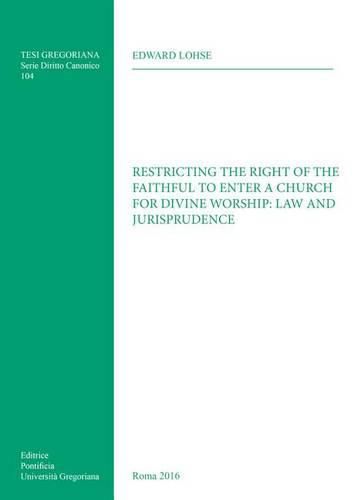Readings Newsletter
Become a Readings Member to make your shopping experience even easier.
Sign in or sign up for free!
You’re not far away from qualifying for FREE standard shipping within Australia
You’ve qualified for FREE standard shipping within Australia
The cart is loading…






This study examines the nature and content of the right of the faithful expressed in can. 1214 to enter a church for the purpose of exercising divine worship, and considers how the jurisprudence of the Holy See can be applied to restrictions placed upon the exercise of that same right. Specifically, this work addresses four questions: 1) What is the right of entry into churches for the exercise of divine worship, as expressed in can. 1214? 2) Who may restrict the exercise of this right? 3) For what reason may it be restricted? And 4) How far may it be restricted? Two important distinctions are present throughout the course of this study. The first is between the actual extinction of the right of entry relative to a given church edifice and the mere restriction of the exercise of that same right, The second distinction is between the objective right of entry, static in nature and defined by law, and the corresponding subjective right, able to be exercised and therefore subject to restrictions. As this study demonstrates, prior to the 1917 Code, the right of entry developed separately in regard to churches and in regard to oratories. A textual study of both the 1917 and 1983 Codes examines not only the objective right of entry, but also related canons which did or still do affect the exercise of the corresponding subjective right. This work identifies key elements of the jurisprudence of the Holy See concerning the extinction of the right of entry relative to individual churches, and then explores how that same jurisprudence could be applied to the mere restriction of the right, rather than to its extinction. A practical method is proposed for assessing the lawfulness of such restrictions. The study concludes with a look toward the future.
$9.00 standard shipping within Australia
FREE standard shipping within Australia for orders over $100.00
Express & International shipping calculated at checkout
This study examines the nature and content of the right of the faithful expressed in can. 1214 to enter a church for the purpose of exercising divine worship, and considers how the jurisprudence of the Holy See can be applied to restrictions placed upon the exercise of that same right. Specifically, this work addresses four questions: 1) What is the right of entry into churches for the exercise of divine worship, as expressed in can. 1214? 2) Who may restrict the exercise of this right? 3) For what reason may it be restricted? And 4) How far may it be restricted? Two important distinctions are present throughout the course of this study. The first is between the actual extinction of the right of entry relative to a given church edifice and the mere restriction of the exercise of that same right, The second distinction is between the objective right of entry, static in nature and defined by law, and the corresponding subjective right, able to be exercised and therefore subject to restrictions. As this study demonstrates, prior to the 1917 Code, the right of entry developed separately in regard to churches and in regard to oratories. A textual study of both the 1917 and 1983 Codes examines not only the objective right of entry, but also related canons which did or still do affect the exercise of the corresponding subjective right. This work identifies key elements of the jurisprudence of the Holy See concerning the extinction of the right of entry relative to individual churches, and then explores how that same jurisprudence could be applied to the mere restriction of the right, rather than to its extinction. A practical method is proposed for assessing the lawfulness of such restrictions. The study concludes with a look toward the future.